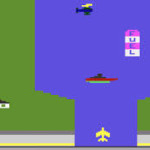LAUDATO SI – On care for our common home
Encyclical letter of Pope Francis.
On ecology, economic justice, and how humans share the world as family.
Ceteris Paribus Logic as general framework for Modal and Game Logics
In the article “The Ceteris Paribus Structure of Logics of Game Forms” authors Davide Grossi,
Emiliano Lorini, and Francois Schwarzentruber propose a generalization to the multitude of logic models applied in game and agent formal analysis.
Authors sudied common aspects of formal models used to represent choice and power currently used in modal logics such as ‘Seeing to it that’, ‘Coalition Logic’, ‘Propositional Control’, and ‘Aternating-time tempral logic’ among others.
“The quest to save today’s gaming history from being lost forever” by Kyle Orland
article from arstechnica
“The very nature of digital [history] is that it’s both inherently easy to save and inherently easy to utterly destroy forever.”
“While the magnetic and optical disks and ROM cartridges that hold classic games and software will eventually be rendered unusable by time, it’s currently pretty simple to copy their digital bits to a form that can be preserved and emulated well into the future.
But paradoxically, an Atari 2600 cartridge that’s nearly 40 years old is much easier to preserve at this point than many games released in the last decade. Thanks to changes in the way games are being distributed, protected, and played in the Internet era, large parts of what will become tomorrow’s video game history could be lost forever. If we’re not careful, that is.” read full article
“Learning Relational Event Models from Video” by Krishna S. R. Dubba, Anthony G. Cohn, David C. Hogg
In this paper scientists from the University of Leeds introduce a new structure for supervised relational learning of event models.
Inductive Logic Programming and other machine learning techniques are adapted to use video data. Efficiency balances generalization and over especification deploying layers of differentiated hierarchy of object types.
Experimental results presented suggest that the techniques are suitable to real world scenarios.
Crowdsource as a computing system for multiple human inputs
In this paper “A U.S. Research Roadmap for Human Computation“, authors Pietro Michelucci, Lea Shanley, Janis Dickinson, Haym Hirsh studies how internet and web-based mutliple contributors to bring great knowledge achievements. Duolingo, Wikipedia being high profile examples.
Human computation is the proposed new field to study how scientific research collaboration may work on new platforms.
“Losing the thread” – by Virginia Postrel
article featured in aeon reminds us about the history of textile technology.
It might be the case that ideas such as Google’s Project Jacquard comes to add a thread the fabric, but still textile as a stand-alone tech case brings more attention to non-computing tech many often downplay..
From the article:
The story of technology is in fact the story of textiles. From the most ancient times to the present, so too is the story of economic development and global trade. The origins of chemistry lie in the colouring and finishing of cloth. … In ways both subtle and obvious, textiles made our world.
(…)
As late as the 1970s, textiles still enjoyed the aura of science. Since then, however, we’ve stopped thinking of them as a technical achievement. In today’s popular imagination, fabric entirely belongs to the frivolous world of fashion. Even in the pages of Vogue, ‘wearable technology’ means electronic gadgets awkwardly tricked out as accessories, not the soft stuff you wear against your skin – no matter how much brainpower went into producing it. …
This cultural amnesia has multiple causes. The rise of computers and software as the very definition of ‘high technology’ eclipsed other industries. Intense global competition drove down prices of fibres and fabric, making textiles and apparel a less noticeable part of household budgets, and turning textile makers into unglamorous, commodity businesses. Environmental campaigns made synthetic a synonym for toxic. And for the first time in human history, generations of women across the developed world grew up without learning the needle arts.
As understandable as it might be, forgetting about textiles sacrifices an important part of our cultural heritage. It cuts us off from essential aspects of the human past, including the lives and work of women. It deprives us of valuable analogies for understanding how technology and trade transform economies and culture. It blinds us to some of today’s most pervasive innovations – and some of tomorrow’s most intriguing…. read full article
Upload me – the setup guide for your virtual self
Anders Sandberg and Nick Bostrom, from Oxford University’s Faculty of Philosophy “Whole Brain Emulation: A Roadmap“
“Putting the Data Science into Journalism” By Keith Kirkpatrick
“The key attributes journalists must have—separate fact from opinion, find and develop sources, and curiosity to ask probing, intelligent questions—are still relevant today’s 140-character-or-less, ADHD-esque society. Yet increasingly, journalists dealing with technical topics often found in science or technology are turning to tools that were once solely the province of data analysts and computer scientists.
Data mining, Web scraping, classifying unstructured data types, and creating complex data visualizations uncover data that would be impossible to compile manually.
“It is about giving the audience information that is unique, in-depth, that allows them to explore the data, and also engage with the audience,” says David Herzog, a professor at the University of Missouri…” read story
Moore’s law turned 50. As fresh now as then.
Then 10 years later, in 1975, Moore comments to an Intel publication: “40 years later? be true? – Of Course”. Amazing then as now.






